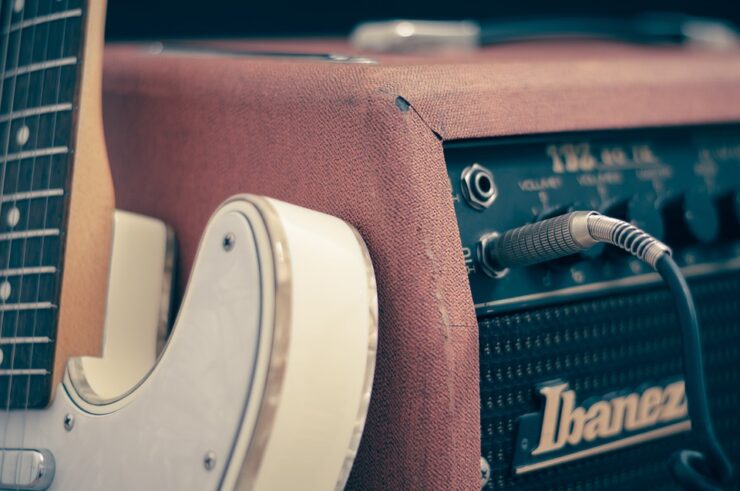Electric guitar makes use of several effects like reverb, distortion, and overdrive. This instrument was invented in 1931 and was first adopted by jazz players. And from that moment onward, it has continued to gain popularity among music players all around the world.
Electric guitars are very different from other forms of guitars. The sound produced is unique. The build is very different, so also is the working process of this guitar.
In this article, we are going to explore some vital information like factors that add uniqueness to the electric guitar. How powerful is the electric guitar? What is the working pattern of the electric guitar? Follow along as we discuss some vital information in this post.
The Electric Guitar

The electric guitar is a type of guitar that makes use of more pickups to convert the vibrations of its strings into electrical signals. The vibrations that are transferred into electric signals occur when you tap, pluck, or fingerpicks the strings.
Electric guitars make use of electromagnetic induction to create the signals. Since the sound produced is weak, it is sent into an amplifier before being delivered into the speakers. The speaker then converts it to audible sounds.
These basics give an insight into how the electric guitar works. To understand the working process of the electric guitar better, let’s consider some of its unique components.
Read: Best Electric Guitar For Short Fingers
The Electromagnetic Feature of Electric Guitar

Electromagnetic induction is a significant force powering electric guitar. It is the same as the dynamo used in your bicycle for powering it when you ride at night. The dynamo generates electricity with two of its part, the coil that rotates inside the hollow, and the curved magnet.
The guitar strings are like dynamos, and their movement help creates electricity. Under each string are pickups which are electricity-generating devices. Each pickup contains magnets that contain coils of very thin wires that are all wrapped around them.
The magnetic field is generated with the magnet around the guitars, and this is passed through the strings. This then results in the magnetization of the string, and their vibration results in the creation of mall electricity that flows through the pickup coil wires.
The pickups are also attached to an amplifier and an electrical circuit. This helps in boosting the small electric currents that pass through it, then into the speaker as explained previously. In most cases, both the amplifier and the loudspeaker are both built into one single unit referred to as AMP.
How Does the Guitar Pickup Work?

The way the pickup of the electric guitar you are using is designed will determine the quality of sound that will be produced. So, not all electric guitars will produce the same type of sound.
- The bar magnet in the pickup help in generating a magnetic field all around the pickup
- The guitar strings are then magnetized, due to the effect of the magnetic field. And the magnetic field changes as vibrations occur.
- The coil of thin wire around the pickup detects this active magnetic field. This field now creates a small current in the coil.
- The amplifier at this point boosts the electric current resulting in the creation of larger current to power the loudspeaker.
- The loudspeaker converts the electric current into sound.
Read: Best Strings for Telecaster Twang
Components of Electric Guitar

Here are some of the components of electric guitar that you should know;
Body
Electric guitar features a solid and thin body. This is in stack difference to an acoustic guitar which often features a hollow shape and produces sound via resonance. The body can be made from wood, aluminium, plastic, or brass. In fact, some make use of 3D-printed guitars.
Frets, Neck, and Strings
Electric guitar features metal strings that run from the body to the neck and frets. These strings are then wound around the tuning peg. If you keep pressing a string at a fret, it results in changing the tension, the frequency, and note.
One reason why most electric guitar makes use of metal strings is to ensure that the guitar interacts well with the magnetic pickup, as this will help the electric guitar produce high-quality sounds.
Bridge and Whammy Bar
The design of this part might differ from guitar to guitar, but the function never changes. The function of the bridge and the tailpiece is to anchor the strings to the body of your guitar. They are arranged parallel to the pickups.
The tremolo arm or the whammy bar are also attached to the bridge. The function is to loosen and tighten strings that are attached to the electric guitar. This help distorts the sounds and results in the creation of wavering effects.
Volume, Tone, and Pickup Selector
You can adjust the way your guitar sounds with the help of the volume and tone knob. The volume can be adjusted easily to support the sound and genre you’re playing. The tone knob regularly interacts with the capacitor to get rid of high frequencies and produce warm and full sounds.
With the pickup selector, a guitarist can play the particular sound they want. You can pick or select either single pickup or combined pickups. Pickups are different in frequency due to their location. The pickup located near the bridge is the highest pickup with high frequency. The one close to the neck is the low and as low frequency.
Conclusion

Undoubtedly, the efficiency and quality of sound produced have been the primary reason why the electric guitar has become popular among guitarists.
This article has discussed the working process of this guitar and the significant components that make up the guitar. No matter the genre you play, the electric guitar is designed to help you bring out the best style of play.

